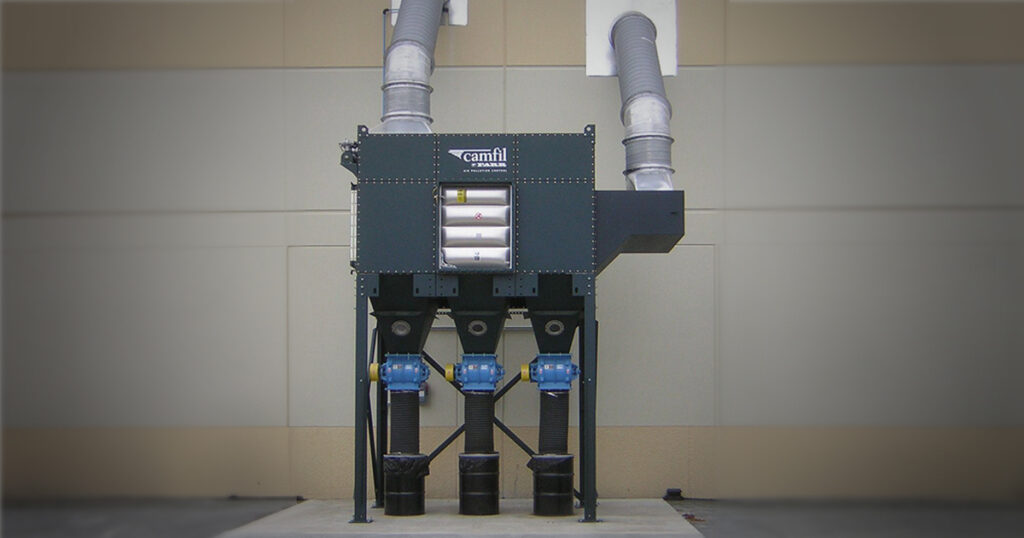
Dust collectors are perhaps one of the more underappreciated pieces of equipment supporting the safe operation of modern manufacturing facilities. They remove hazardous contaminants and pollutants that affect indoor and outdoor air quality, provide clean and safe working environments, and mitigate fire and explosion hazards. But there is a serious danger in using these revolutionary tools. Fire with explosive potential is always a concern when you have finely divided particles of combustible dust and the presence of an ignition source.
The primary elements necessary for a dust fire and/or explosion are oxygen, fuel, and heat. When they come together at the same time, the results can be catastrophic. Implementing a dust collector spark detection system can be a lifesaving decision when dealing with volatile waste, combustible dust, and other fire hazards.
Learn how a spark detection system in your facility can protect people and property and prevent catastrophe in this blog, the first in our series highlighting the importance of spark detection.
Dust Collectors & Fire Risk
Industrial dust collectors capture and contain the fine particulate produced in the production environment. Uncontrolled dust emissions in the plant can irritate eyes and lungs and make your facility a mess, but fire and explosions are a far more significant risk. Just a thin layer of accumulated dust on production equipment, ceilings, and other surfaces can provide the kindling needed for an explosion should a spark be introduced into the environment. OSHA even uses the “paperclip rule” as a standard measurement to determine the depth of accumulated dust that presents a fire and explosion hazard.
Many manufacturing processes utilize air pneumatic conveyance systems to move products or byproducts throughout the plant. These conveyance systems transport waste and by-product through a network of enclosed ducts. Should a spark or other ignition source enter the ductwork it will quickly travel to the dust collector, risking an explosion and fire of catastrophic proportions. Spark detection and extinguishing systems have become a common addition to air conveyance systems that transport flammable or explosive dusts. They extinguish the ignition source as it travels through the ducting before it ever reaches the dust collector. These systems can stop a spark in its tracks, protecting life, property, and production.
How Does Spark Detection Work?
Spark detection systems use specialized sensors that monitor and detect sparks in an enclosed environment, such as air conveyance ducting, to mitigate the risk of fire and explosion. These sensors are placed at various points throughout the conveyance ducting to detect the presence of infrared light. The sensor’s field of view can detect the light created by anything that produces heat, and sparks produce more infrared light than the environment in which they occur.
What About Fire Suppression Systems?
When a spark is detected in your conveyance system, the spark detector can recognize the rapid change in the infrared light from hot particles. Once identified, the spark detection system will activate the suppression system components within the ductwork. Strategically placed nozzles deploy fine mists of water to douse the spark and stop it from igniting other materials within the duct, thus preventing a fire from reaching the dust collector. When you install a spark detection system with fire suppression features, you can protect your staff, facility, and product while maintaining compliance with NFPA standards.
Maintain Compliance with the Perfect Combination
If your operation includes dust collection, ensure you’ve covered all your bases with a dust collector spark detection system. It’s easy to underestimate the damage and repercussions of a tiny spark, but with a multi-pronged approach to fire safety, especially in industries like printing and finishing, packaging, and paper converting, the potential cost of non-compliance with combustible dust is not a risk worth taking.
Be sure to implement the best dust collection, spark detection, and fire suppression systems available. Don’t be one of the many manufacturers responsible for injuries, lost products, damaged facilities, and worse.
If you’re unsure where to start with this process, contact AES. Our experts have installed countless dust collector units with spark detection and fire suppression systems.
Our ability to improve the safety and cleanliness of your facility doesn’t end at dust collection. Check out our entire offering of waste management equipment and see what our expertise can do for your business.
